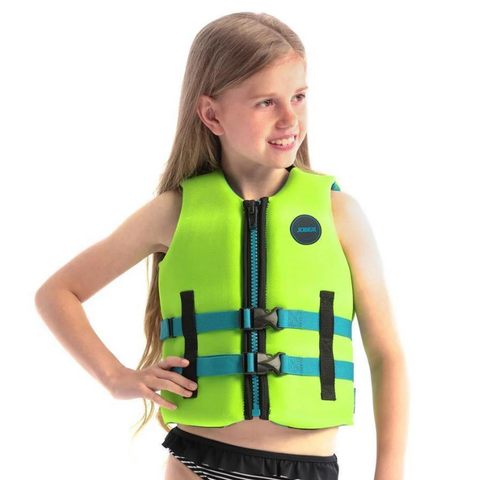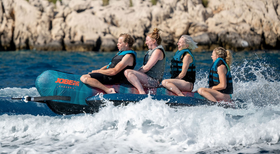
Choosing the right Life Jacket for Children: Neoprene vs. Nylon
When it comes to ensuring the safety of children around water, few pieces of equipment are as crucial as life jackets. Not only are they essential for inexperienced swimmers, but they can be lifesaving in emergencies.
Among the most common materials used in life jacket construction are neoprene and nylon, each offering distinct features and benefits. Understanding the differences between these materials is important, especially when it concerns the safety of young ones.

Neoprene Life Jackets: Comfort and Flexibility
Neoprene life jackets are favoured for their comfort and flexibility. Made from a synthetic rubber material, neoprene jackets provide a snug fit, making them comfortable for extended wear. This snug fit also ensures that the life jacket stays securely in place, reducing the risk of slipping off in the water. Additionally, neoprene offers excellent buoyancy properties, keeping the wearer afloat effortlessly.
One of the key advantages of neoprene life jackets is their insulation properties. This material retains heat well, which makes it ideal for colder water conditions or cooler climates. For children who might be swimming in chilly waters or during cooler seasons, a neoprene life jacket can provide added warmth and comfort.
Furthermore, neoprene life jackets often come in stylish designs and vibrant colours. Convincing junior to wear his life jacket is easier when they look cool. The combination of comfort, buoyancy and style makes neoprene life jackets a popular choice among parents.

Nylon Life Jackets: Durability and Affordability
Nylon life jackets, on the other hand, are known for their durability and affordability. Constructed from rugged nylon fabric, these life jackets are built to withstand wear and tear, making them suitable for rougher water activities and more adventurous children. The foam panels inside the nylon ensure that the wearer floats while still allowing enough movement in the water. The sturdy construction of nylon life jackets ensure longevity, providing reliable safety for multiple seasons.
Another advantage of nylon life jackets is their affordability. Compared to neoprene jackets, nylon vests are more budget-friendly, making them an attractive option for families on a budget.
Additionally, nylon life jackets are lightweight and quick-drying, making them convenient for travel and outdoor activities. Their quick-drying nature reduces the risk of mould and mildew buildup, ensuring that the life jacket remains clean and hygienic for repeated use.

The Importance of Life Jackets for Children
Regardless of the material, the importance of life jackets for children cannot be overstated. Drowning is one of the leading causes of accidental death among children, especially in environments with open water such as beaches, lakes, rivers and swimming pools. A properly fitted and appropriate life jacket can significantly reduce the risk of drowning by providing buoyancy and keeping your child afloat.
It's essential for parents and caregivers to choose a life jacket that is suitable for the child's age, weight and swimming abilities. Additionally, ensuring a proper fit is crucial to the life jacket's effectiveness. Small children should never wear an adult-size life jacket as they may be too loose and may slip off in the water.
When it comes to selecting a life jacket for children, both neoprene and nylon options offer distinct advantages. Neoprene jackets provide comfort, flexibility and insulation, while nylon jackets offer durability, affordability and quick-drying properties.
Ultimately, the choice between neoprene and nylon will depend on factors such as personal preference, budget and intended use. Regardless of the material chosen, the most important consideration is that the life jacket fits and meets safety standards to ensure the protection of young swimmers.


